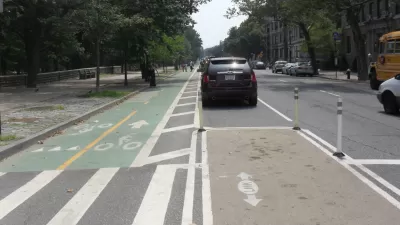Over 100 years ago, a wooden bicycle highway linked Pasadena to Los Angeles. Now cycling activists are hoping that, by closing the Arroyo Seco Parkway to automobiles for "ArroyoFest," Angelinos can once again imagine a cycling future for LA.
"In 1900, southern California created a futuristic traffic structure catering to the mechanical marvel of the day--the bicycle. It opened along a corridor known as the Arroyo Seco, named for the seasonal stream that flows from the San Gabriel Mountains and enters the Los Angeles River just north of downtown Los Angeles.
It was part of a grand plan to connect Los Angeles to Pasadena through an eight-mile 'great transit artery.' A Pasadena mayor, Horace Dobbins, provided the start-up funds to create an elevated, multilane, wooden 'cycleway,' complete with streetlights and gazebo turnouts.
When the first leg opened, swarms of bicyclists handed over the 15-cent toll. A Los Angeles Times commentator gushed that the countryside it passed through 'is the loveliest in Southern California, the route having been chosen with an eye to scenic beauty as well as to practical needs.'
The Los Angeles region, with its mild Mediterranean climate and relatively flat terrain, was in fact considered an ideal home for the bicycle, with more than 20 percent of the population biking for pleasure or to work when the cycleway was proposed.
'There is no part of the world where cycling is in greater favor than in Southern California, and nowhere on the American continent are conditions so favorable the year round for wheeling,' one 1897 newspaper article commented. The bicycle use complemented the city's streetcars.
Soon the automobile gained popularity, however, and the elegant bicycling structure was eventually dismantled. Early discussion of car routes, meanwhile, highlighted the concept of a "parkway" as part of a mixed-transit system, built along scenic corridors with adjacent parkland.
By the 1940s, Los Angeles, like other regions, had begun to reorient its transportation planning to exclusively favor the car, and the parkway officially became the Pasadena Freeway in 1954. With the passage of the Federal-Aid Highway Act of 1956 and its dedicated Highway Trust Fund, the car and the utilitarian freeway triumphed.
...It took years of discussion to articulate the full-blown plan for ArroyoFest, an event we hoped would, among other goals, help Angelenos imagine bikes once again playing an important role in moving people around the city."
FULL STORY: Bikeway or the Highway

Alabama: Trump Terminates Settlements for Black Communities Harmed By Raw Sewage
Trump deemed the landmark civil rights agreement “illegal DEI and environmental justice policy.”

Study: Maui’s Plan to Convert Vacation Rentals to Long-Term Housing Could Cause Nearly $1 Billion Economic Loss
The plan would reduce visitor accommodation by 25% resulting in 1,900 jobs lost.

Why Should We Subsidize Public Transportation?
Many public transit agencies face financial stress due to rising costs, declining fare revenue, and declining subsidies. Transit advocates must provide a strong business case for increasing public transit funding.

Paris Bike Boom Leads to Steep Drop in Air Pollution
The French city’s air quality has improved dramatically in the past 20 years, coinciding with a growth in cycling.

Why Housing Costs More to Build in California Than in Texas
Hard costs like labor and materials combined with ‘soft’ costs such as permitting make building in the San Francisco Bay Area almost three times as costly as in Texas cities.

San Diego County Sees a Rise in Urban Coyotes
San Diego County experiences a rise in urban coyotes, as sightings become prevalent throughout its urban neighbourhoods and surrounding areas.
Urban Design for Planners 1: Software Tools
This six-course series explores essential urban design concepts using open source software and equips planners with the tools they need to participate fully in the urban design process.
Planning for Universal Design
Learn the tools for implementing Universal Design in planning regulations.
Smith Gee Studio
Alamo Area Metropolitan Planning Organization
City of Santa Clarita
Institute for Housing and Urban Development Studies (IHS)
City of Grandview
Harvard GSD Executive Education
Toledo-Lucas County Plan Commissions
Salt Lake City
NYU Wagner Graduate School of Public Service




























